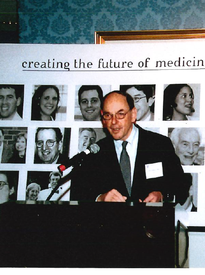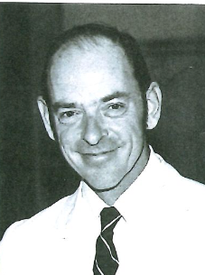- Department
- 150 Year Anniversary
- Timeline
- Arthur K. Asbury, Chair
Check out Dr. Sumner talk about distinct challenges in Neurology: Check out the full video here: Austin Sumner
Check out Dr. Ginsberg talk about the future: Check out the full video here: https://upenn.box.com/s/na2tsu25kbqbsq0j8iqaspn0vmyk8jsh
Check out Dr. Rostami talk about diversity and inclusion: Check out the full video here: https://upenn.box.com/s/orh947rqzbv8kdyioznib9r34aeffrwh
Check out Dr. Packer talk about mentors: Check out the full video here: https://upenn.box.com/s/jhs18xa1nx2luju3fi62mzegam84ajdv
Arthur K. Asbury, Chair, 1974 — 1982

Dr. Arthur Knight Asbury, Van Meter Professor of Neurology Emeritus at the Perelman School of Medicine of the University of Pennsylvania, is renowned for his pioneering clinical and experimental studies of peripheral neuropathies. In particular, he shed light on neuropathies in patients with chronic kidney failure, diabetes mellitus, and the acute inflammatory polyneuropathy known as Guillain-Barré syndrome.
The son of two physicians, Arthur K. Asbury was born in 1928 in Cincinnati, Ohio. He grew up in Cincinnati and in Nicholas County, Kentucky, where his family bred thoroughbred race horses, including the 1954 Kentucky Derby winner, “Determine.” He was graduated from Phillips Academy Andover in 1946. Dr. Asbury earned a Bachelor of Science degree in agriculture from the University of Kentucky in 1951 and then served two years of active duty in the U.S. Army Reserve, where—based on his B.S. degree—he was assigned to the First Guided Missile Group as an instructor. He credited his military experience with helping him learn about himself (independent of his family), about his scientific abilities, and about leadership. He earned a medical degree from the University of Cincinnati College of Medicine in 1958, graduating first in his class. Dr. Asbury’s postgraduate training in medicine, neurology, pathology and neuropathology was fulfilled at Massachusetts General Hospital and Harvard Medical School. Dr. Asbury became Chief of the Neurology Service at the San Francisco Veterans Administration Medical Center in 1969. Concurrently, he was first Associate Professor and then Professor of Neurology and Pathology and Vice Chair of the Department of Neurology at the Medical School of the University of California, San Francisco.
In 1973, following a year-long national search during which Dr. Donald H. Silberberg served as interim chair, Dr. Asbury was selected as Chair of Neurology at the University of Pennsylvania School of Medicine. His appointment came close to being scuttled before it was finalized: after protracted negotiations, the man who had confirmed the terms, Dr. Robert Dripps, suddenly died on the tennis court. He and Dr. Asbury had reached a “handshake deal” over the phone with nothing in writing. Fortunately, Dr. Dripps had made a cassette tape of his final phone call with Dr. Asbury before going to play tennis, and it was discovered a week later. Dr. Asbury assumed the role of Chair in 1974 and stepped down for health reasons in 1982. The following year, he was appointed the first Van Meter Professor of Neurology.
Over the next fifteen years Dr. Asbury served in deanships at the University of Pennsylvania Medical Center. He was Interim Dean and Executive Vice President of the University of Pennsylvania Medical Center in 1988-89. Subsequently he fulfilled a three-year term as Vice Dean for Research and a four-year term as Vice Dean for Faculty Affairs. Dr. Asbury again became Interim Dean of the School of Medicine in 2000-2001.

Source
(Pending to be included)
Major Discoveries and Events at Penn during this time
- The first in-vivo measurement of local cerebral blood volume in animals and men also was performed at HUP
- 1976 - 100 years after women first enrolled in the College as "special students," the University had become fully co-educational. Penn's thirteen schools were open to men and women "on equal terms," and women were enrolled in every degree program offered by the University. Women were likewise members of the standing faculty in all thirteen schools. Women had also entered the field of senior academic administration and served with distinction as deans of the College of Women, Nursing, and Social Work schools. One of the two Vice Provosts of the University was a woman and women held two of the senior staff positions in the Office of the President. Five women were Trustees of the University.
- 1979 - In January, the University amended its non-discrimination policy to prohibit discrimination on the basis of sexual orientation. By March, Margaret Helen (“Maggie”) Childs (Ph.D., May 1983) had emerged as a leader of the Lesbians at Penn (LAP). In the spring of 1980, LAP merged with its male counterpart, Gays at Penn (GAP). The combined student organization took the name Lesbians and Gays at Penn (LGAP) and was formally recognized by the Student Activities Council (SAC). In the fall of 1981, the first woman to lead the combined LGAP was Teresa J. Grubbs (A.B., 1983).
Major Translational Research and Clinical Advances during this era
- The first fluorodeoxyglucose positron emission tomography (PET)image was obtained at HUP
- The first hospital-based magnetic resonance imaging (MRI ) in the country became operational
- 1981: Established the criteria for the diagnosis of Guillain-Barré syndrome (determined by the committee he chaired for the National Institute of Neurological Disorders and Stroke) in “Diagnostic considerations in Guillain-Barré syndrome” in Annals of Neurology
- 2004: Perelman School of Medicine established the Arthur K. Asbury Award for Outstanding Faculty Mentoring
People of this era
Pending till receiving the content
Neurology Firsts of this Era
N/A
